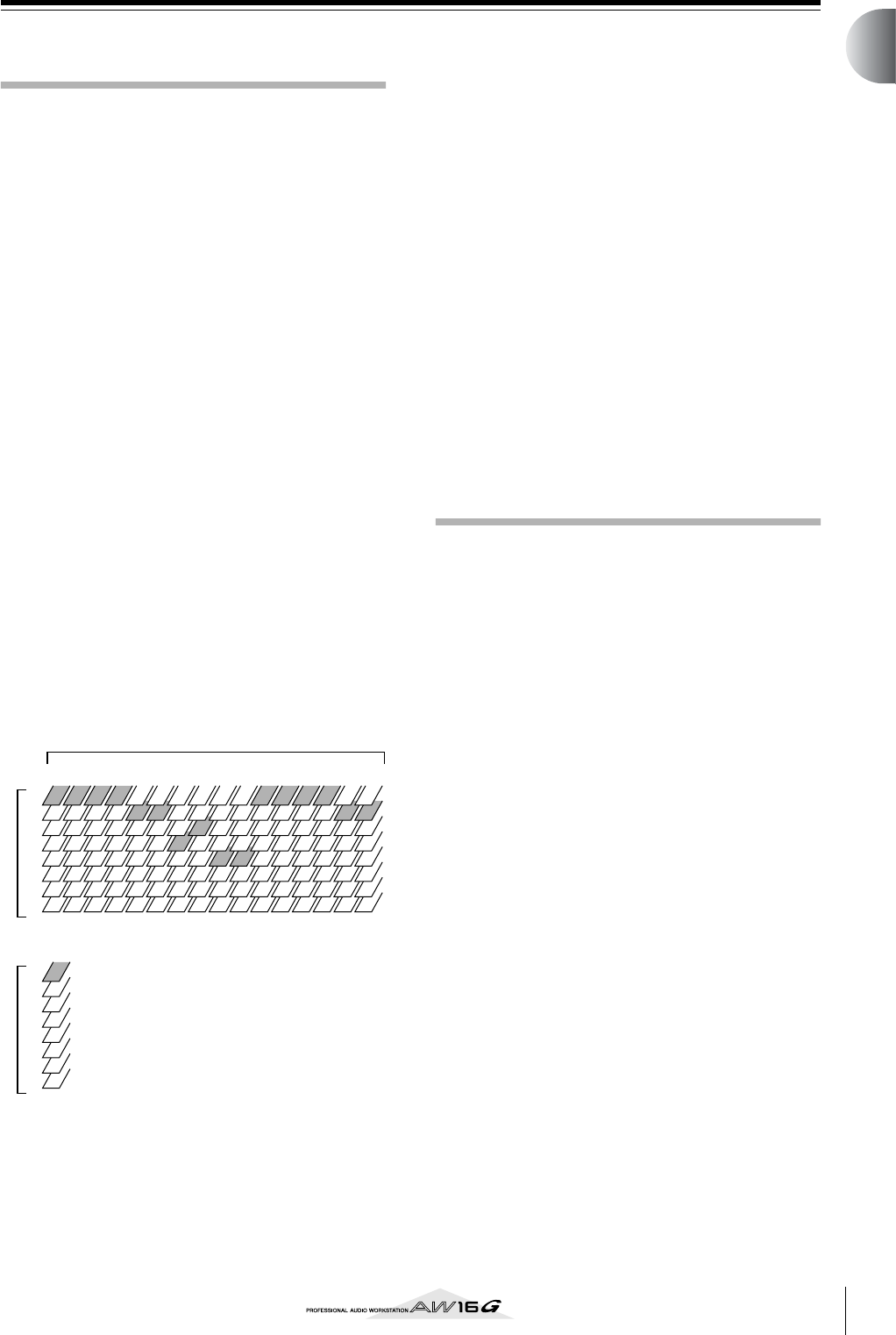
15
Introducing the AW16G
2
AW16G terminology
Recorder section
■ Tracks
A location where data is recorded is called a “track.” The
AW16G’s recorder section uses the following types of
track.
● Audio tracks
The physical tracks used to record and play back
audio data are called “audio tracks,” or simply
“tracks.” The AW16G has sixteen audio tracks. You
can record eight tracks simultaneously, and play back
16 tracks simultaneously.
● Stereo track
Independently from audio tracks 1–16, the AW16G
has a “stereo track” that records and plays a stereo
audio signal.
The stereo track is used mainly as a dedicated mix-
down track for recording the final mix.
● Virtual tracks
Each audio track 1–16 and the stereo track consists of
eight tracks. Each of these eight tracks is called a “vir-
tual track.” For the audio tracks and the stereo track,
only one virtual track can be recorded or played at
any time. However, you can switch virtual tracks to
continue recording other takes while preserving the
previously-recorded content.
The diagram below shows the concept of virtual
tracks. The horizontal rows indicate audio tracks 1–
16, and the vertical columns correspond to virtual
tracks 1–8. The shaded areas indicate the virtual track
that is currently selected for recording or playback.
■ Paired tracks
For audio tracks 9/10–15/16, adjacent pairs of tracks are
handled by the mixer as a single unit. These pairs of
tracks are referred to as “paired tracks.” A paired track
can be used to record a stereo source, or a dual-guitar
performance, etc.
■ Locate points/markers
Locations within a song that you specified in order to
execute a function such as auto punch-in/out or A-B
repeat playback are called “locate points.” Locate points
include the in/out points and the A/B points, and you can
use the keys of the Locate section to move instantly to
these points.
Independently of the locate points, you can assign
“markers” at desired locations within a song so that you
will be able to find these locations quickly. The AW16G
lets you set up to ninety-nine markers (1–99). By using
the keys of the Locate section you can move instantly to
the previous or next marker.
Mixer section
■ Channels
A signal route that processes a single signal within the
mixer and sends it to various sections is called a “chan-
nel.” The mixer section of the AW16G lets you use the
following channels.
● Input channels 1–8
These apply EQ and dynamics processing to the sig-
nals that are input from MIC/LINE INPUT jacks 1–8,
and send them to the recorder tracks or to the STE-
REO OUT jacks.
● Track channels 1–16
These channels apply EQ and dynamics processing to
the audio playback signals from audio tracks 1–16 of
the recorder, and send the signals to the stereo track
and the STEREO OUT jacks. You can also perform
“bounce recording” by sending these channels to dif-
ferent tracks.
● Return channels 1/2
These channels send the return signals from the inter-
nal effects to the stereo track and the STEREO OUT
jacks.
● Pad channels 1–4
These channels apply EQ and dynamics processing to
the playback of Quick Loop Sampler pads 1–4, and
send the signals to the stereo track and the STEREO
OUT jacks.
● Stereo output channel
This applies EQ and dynamics processing to the sig-
nal of the stereo bus (which combines the signals of
the various channels), and sends it to the stereo track
or to the STEREO OUT jacks. The same signal is also
output from the MONITOR OUT jacks and from the
PHONES jack.
1
2
3
4
5
6
7
8
1
2 3 4 5 6 7 8 9 10 11 12 13 14 15 16
1
2
3
4
5
6
7
8
Audio tracks
Stereo track
Virtual tracksVirtual tracks


















